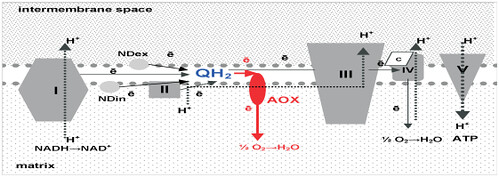Authors: Mukesh Kumar Gupta1 Ashish Marathe2 Rakesh Kumar Prajapat3
1 Ph.D Scholar Division of Plant Physiology, I.A.R.I, New Delhi-110012
2 Ph.D Scholar Division of Biochemistry, I.A.R.I, New Delhi-110012
3 Ph.D Scholar, N.R.C.P.B, New Delhi-110012
Ripening is the process by which fruits attain their desirable flavour, quality, colour, palatable nature and other textural properties. It is associated with change in composition i.e. conversion of starch to sugar. On the basis of ripening behavior, fruits are classified as climacteric and non-climacteric fruits. Ripening of climacteric fruit is influenced by environmental factor (temperature, humidity, shading, nutrition, post-harvest O2 concentration etc) and internal factor like hormone (ethylene) and enzymes like polygalacturonase, alternative oxidase etc. Although the alternative oxidase has been proposed to play a role in fruit development, its function is unclear (4).
AOX protein levels increased dramatically in tomato fruit ripened on the vine. Similar increases have been reported in mango and apple fruit in which climacteric bursts were associated with an enhanced CN-insensitive respiration. The expression of alternative oxidase (AOX) was investigated during ripening in mango. The multigene family for the AOX in mango was expressed differentially during ripening. Abundance of AOX protein peaked at the ripe stage. The pattern of protein accumulation suggested that increases in cytochrome chain components played an important role in facilitating the climacteric burst of respiration and fruit ripening (1). To gain further insight into the role of AOX in tomato fruit repining, transgenic tomato plants were generated. Tomato plant with reduced LeAOX1 levels exhibited retarded ripening, reduced carotenoids, respiration and ethylene production and the down regulation of ripening associated genes. The fruit that overexpress LeAOX1a accumulated more lycopene, and displayed a similar pattern of ripening to wild type fruit. Ethylene application promoted fruit ripening and accelerated ethylene production and respiration, including the alternative pathwayrespiration. The transgenic plants with reduced LeAOX level failed to ripen after 1-methylcyclopropane treatment, while such inhibition was less effective in 35S-AOX1a fruit. These finding indicate that AOX is involved in climacteric respiration and ethylene-mediated fruit ripening of tomato (2).
Plant respiratory chain branches at the level of ubiquinone from where the electrons flow through the cytochrome pathway or to alternative oxidase. Transfer of electrons from ubiquinone to oxygen by alternative oxidase has a non-protonmotive character.
Alternative oxidase catalyzes cyanide-resistant reduction of oxygen to water without translocation of protons across the inner mitochondrial membrane, and thus functions as a non-energy-conserving component of the respiratory electron transfer chain. I, NADH - ubiquinone oxidoreductase; II, succinate-ubiquinone oxidoreductase; III, ubiquinol - cytochromec oxidoreductase; IV, cytochrome c oxidase; V, ATP synthase; AOX, alternative oxidase; cytochrome c; QH2, ubiquinol (reduced ubiquinone); ND ex/in, NAD(P)H dehydrogenases, respectively external/ internal.
Alternative oxidase in plant mitochondrial respiratory chain

There are two forms of AOX :
1. Active form (reduced form)
2. Inactive form(oxidized form)
The AOX is a dimer at its inactive (oxidized) form. The dimer is split to two proteins at its active (reduced) form. For the purpose of transporting the electrons, the AOX has a putative iron binding site at its C terminal and the cysteine peptide which enables the formation of the active and inactive forms is located towards the N terminal.
Function of AOX:
Thermogenesis, Pollination, Energy overflow , Reductant overflow, Continuation of citric acid cycle ,cyanide resistance , AOX is thought to play roles in heat production of thermogenic floral organs and cell adaptation under environmental stresses, such as inhibition of reactive oxidase species (ROS) formation and optimization of photosynthesis. To date, limited information exists on the contribution of the AOX pathway to fruit ripening.
Thus we can infer that alternative oxidase has role in fruit ripening by mediating ethylene signaling as well as scavenging of reactive oxygen species
References:
1. Considine MJ., Daley DO., Whelan J. (2001). The expression of alternative oxidase and uncoupling protein during fruit ripening in mango. Plant Physiology 126: 1619-1629.
2. Xu F., Yuan S., (2012). The role of alternative oxidase in tomato fruit ripening and its regulatory iteraction with ethylene. Journal of Experimental Botany 63: 5705-5716.
3. Zidenga T., Leyva-Guerrero E., Moon H., Siritunga D. and Sayre R. (2012). Extending Cassava Root Shelf Life via Reduction of Reactive Oxygen Species Production. Plant Physiology 159: 1396-1407.
4. Vanlerberghe GC. and Mclntosh L. (1997). Alternative oxidase: from gene to function. Annual Review of Plant Physiology and Plant Molecular Biology 48: 703-734.
About Author / Additional Info: